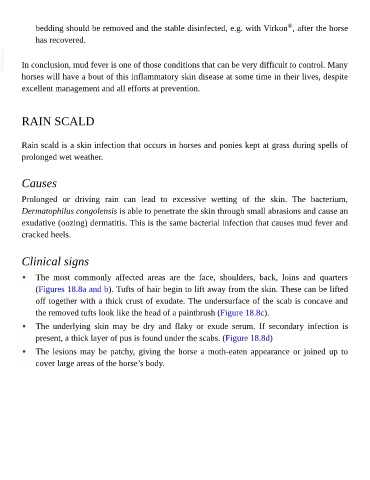Page 830 - The Veterinary Care of the Horse
P. 830
®
bedding should be removed and the stable disinfected, e.g. with Virkon , after the horse
has recovered.
VetBooks.ir In conclusion, mud fever is one of those conditions that can be very difficult to control. Many
horses will have a bout of this inflammatory skin disease at some time in their lives, despite
excellent management and all efforts at prevention.
RAIN SCALD
Rain scald is a skin infection that occurs in horses and ponies kept at grass during spells of
prolonged wet weather.
Causes
Prolonged or driving rain can lead to excessive wetting of the skin. The bacterium,
Dermatophilus congolensis is able to penetrate the skin through small abrasions and cause an
exudative (oozing) dermatitis. This is the same bacterial infection that causes mud fever and
cracked heels.
Clinical signs
• The most commonly affected areas are the face, shoulders, back, loins and quarters
(Figures 18.8a and b). Tufts of hair begin to lift away from the skin. These can be lifted
off together with a thick crust of exudate. The undersurface of the scab is concave and
the removed tufts look like the head of a paintbrush (Figure 18.8c).
• The underlying skin may be dry and flaky or exude serum. If secondary infection is
present, a thick layer of pus is found under the scabs. (Figure 18.8d)
• The lesions may be patchy, giving the horse a moth-eaten appearance or joined up to
cover large areas of the horse’s body.

